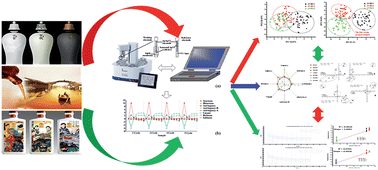Determination of the flavours and marked ages of rice wines using a taste sensing system combined with the Weber–Fechner law and chemometric methods
Abstract
A taste sensing system was used to determine the marked ages and flavours of rice wines. The taste sensing system consisted of five different artificial lipid–polymer membrane electrodes that were highly sensitive to the five basic tastes (umami, astringency, bitterness, sourness and saltiness). This taste sensing system can be used to show the quality and intensity of tastes in samples and detects these tastes in a manner similar to that of the human gustatory system. Three types of rice wine with the same flavour, but different marked ages, and three types of rice wine with same marked age, but different flavours were analysed. A “taste map” analysis was performed to determine taste intensity based on which the tastes could be quantitatively analysed without chemometric methods. The differences in flavour among the rice wines were clearly shown. The responses (including the change in membrane potential caused by adsorption) obtained by the electrodes were analysed using principal components analysis and discriminant function analysis for classification and partial least-squares regression and a support vector machine for forecasting. Discriminant function analysis performed better than principal components analysis in classifying the rice wines with different marked ages and had similar results to principal components analysis in classifying rice wines with different flavours. The support vector machine based on the leave-one-out cross-validation was more stable than partial least-squares regression and the support vector machine based on the ten-fold cross-validation in predicting the marked ages and flavours of different types of rice wine; the prediction correlations were R2 = 0.9568 and R2 = 9620, respectively.


 Please wait while we load your content...
Please wait while we load your content...